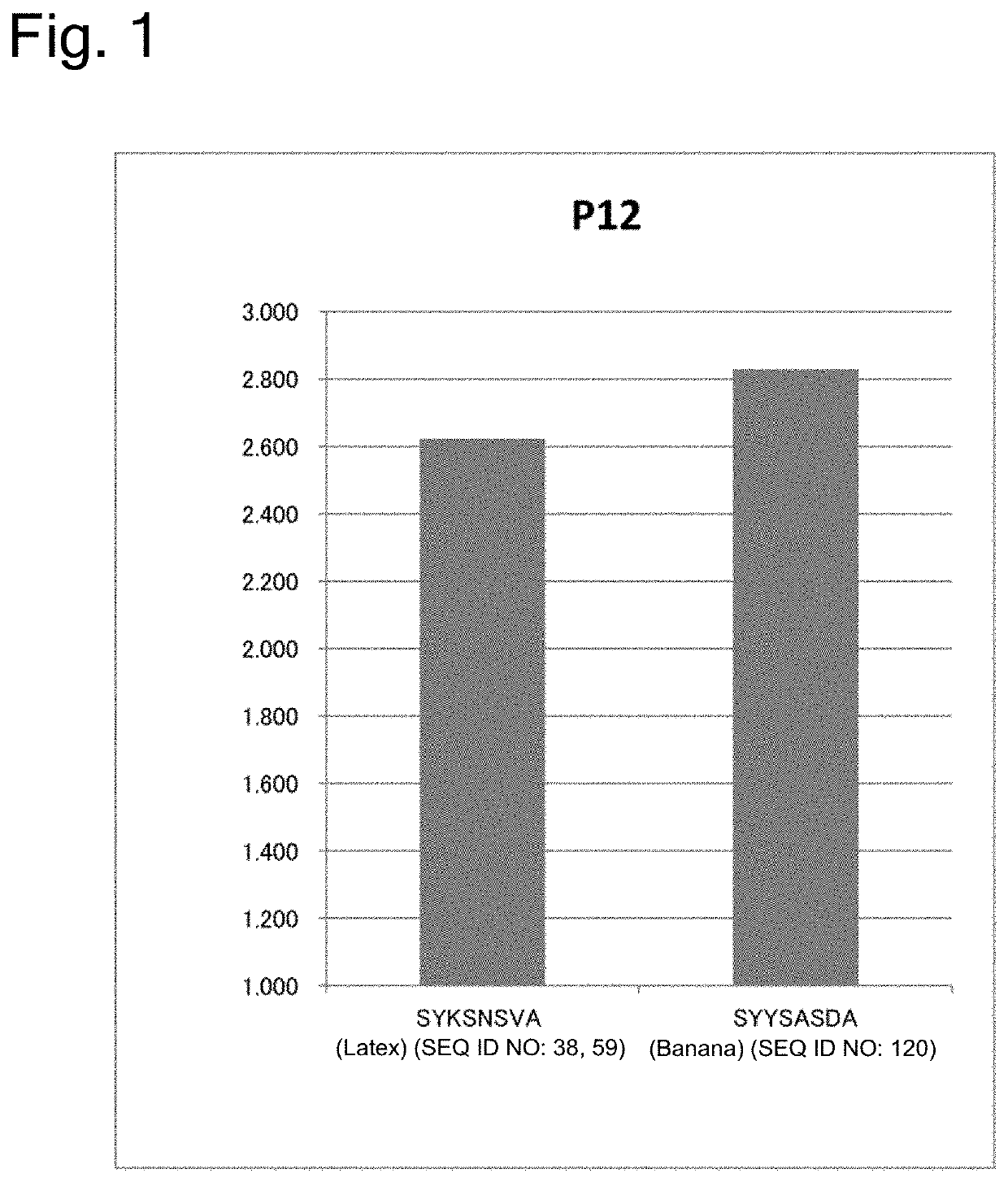Allergy antigen and epitope thereof
an allergen and epitope technology, applied in the field of allergen antigen and epitope thereof, can solve the problems of insufficient detection rate of patients by the measurement of allergen components, insufficient diagnostic efficiency, and still totally rare analyses
- Summary
- Abstract
- Description
- Claims
- Application Information
AI Technical Summary
Benefits of technology
Problems solved by technology
Method used
Image
Examples
example 1
[0203]Proteins contained in latex (Hevea brasiliensis) were investigated using a two-dimensional electrophoresis method described below.
[0204]Protein Extraction
[0205]Extraction and purification of proteins contained in latex were carried out as follows. The proteins were extracted by adding mammalian cell lysis kit; MCL1 (produced by Sigma-Aldrich Co. LLC) to proteins obtained from the sap of natural rubber.
[0206]The constituents of the mammalian cell lysis kit; MCL1 are as mentioned below.
[0207]50 mM Tris-HCl pH 7.5
[0208]1 mM EDTA
[0209]250 mM NaCl
[0210]0.1% (w / v) SDS
[0211]0.5% (w / v) Deoxycholic acid sodium salt
[0212]1% (v / v) Igepal CA-630 (surfactant (Octylphenoxy)polyethoxyethanol produced by Sigma-Aldrich Co. LLC)
[0213]Appropriate Amount of Protease Inhibitor
[0214]Thereafter, the precipitation procedure was repeated twice using 2D-CleanUP Kit (produced by GE). In the first round of precipitation, the collected liquid protein extract was precipitated by add...
example 2
ation of Antigens by Immunoblotting
[0253]Identification of antigens by immunoblotting was carried out by taking all the steps up to the step of “Second-dimensional SDS-PAGE” as described above in Example 1, followed by the steps of “Transfer to membrane”, “Immunoblotting” and “Analysis” as described below.
[0254]Transfer to Membrane
[0255]Transfer to membrane was done using the following transfer system and transfer buffer.
Transfer system: XCell SureLock Mini-Cell and XCell II Blot Module (produced by Life Technologies)
Transfer buffer: NuPAGE Transfer Buffer (X20) (produced by Life Technologies), used in a form diluted 200-fold with milliQ water.
[0256]To be specific, proteins in the two-dimensional electrophoresis gels were transferred to a membrane (PVDF membrane) according to the following procedure.
[0257](1) The PVDF membrane was immersed in 100% methanol followed by milliQ water, and then moved into the transfer buffer to hydrophilize the PVDF membrane.
[0258](2) After sponge, filt...
example 3
trometry and Identification of Antigens
[0265]The amino acid sequences of the antigens that form the protein spots were identified by mass spectroscopy.
[0266]To be specific, protein extraction and mass spectroscopy were done by the following procedure.
(1) Latex was subjected to protein extraction, two-dimensional electrophoresis and transfer to membrane by following the procedures described in Example 1 and 2, and the resulting membrane was stained by shaking in a solution of 0.008% Direct blue in 40% ethanol and 10% acetic acid.
(2) Then, the membrane was decolorized by repeating a 5-minute treatment with 40% ethanol and 10% acetic acid three times, washed with water for 5 minutes, and then dried by air.
(3) A protein spot of interest was cut out with a clean cutter blade and put into a centrifugal tube. The cut membrane was subjected to hydrophilization with 50 μL of methanol, followed by washing with 100 μL of water twice and then centrifugal cleaning. Thereafter, 20 μL of 20 mM NH4...
PUM
 Login to View More
Login to View More Abstract
Description
Claims
Application Information
 Login to View More
Login to View More - R&D
- Intellectual Property
- Life Sciences
- Materials
- Tech Scout
- Unparalleled Data Quality
- Higher Quality Content
- 60% Fewer Hallucinations
Browse by: Latest US Patents, China's latest patents, Technical Efficacy Thesaurus, Application Domain, Technology Topic, Popular Technical Reports.
© 2025 PatSnap. All rights reserved.Legal|Privacy policy|Modern Slavery Act Transparency Statement|Sitemap|About US| Contact US: help@patsnap.com

